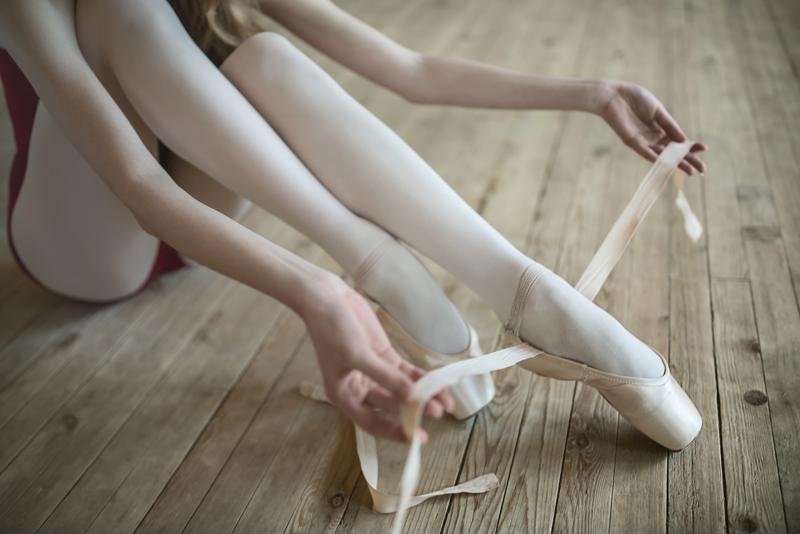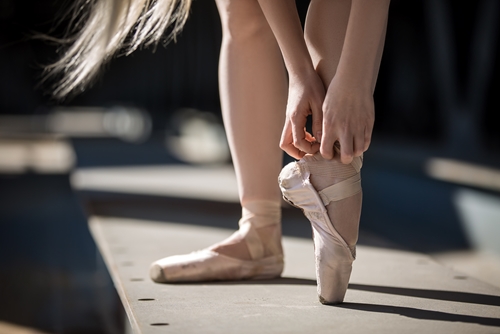Pointe classes are something that shouldn’t be started without the go ahead of an experienced teacher, and only when a dancer is developmentally ready, strong enough and well-versed in foundational technique. When you do get the go-ahead to enroll in pointe or pre-pointe class, you’ll likely be chomping at the bit to put on those silky pink shoes and start pirouetting like the pros. Starting pointe class is a big step for any aspiring ballerina, but it’s not something to be taken lightly. Being prepared both mentally and physically is key to making the most of your first pointe classes, so here are some things first-time students should keep in mind as their initial class approaches.
“Your pointe shoes must match the size and shape of your feet.”
Respect the Pointe Shoes
There’s a lot more to pointe shoes than meets the eye. Think about it this way: Every dancer’s feet are different, so pointe shoes need to be chosen carefully. When you’re dancing in them, you’ll be resting your whole body weight on your toes, so it’s essential that the shoes conform to the shape of your foot as closely as possible. When you go for your pointe shoe fitting, the salesperson will help you determine the best shoe type for your feet, whether it’s a square box, a tapered box or some variation in between.
The video below, from the New York City Ballet, shows just how specific pointe shoe measurements are for professional ballerinas – plus, it shows some great clips of Megan Fairchild in action.
[wpsm_video]https://www.youtube.com/watch?v=XwmwsGT8IQ4[/wpsm_video]
Fit isn’t the only thing you need to think about when it comes to pointe shoes. You’ll also need to learn how to properly sew your shoes, and you’ll want to decide what supplementary materials you need to comfortable dance in them. For example, some ballerinas choose to tape their toes, while others prefer to use toe pads as cushioning. There’s no “wrong” or “right” way to wear your shoes – it’s all about how you’re most comfortable.
Your First Pointe Class
When it’s time for your first pointe class, you’ll probably want to immediately do chaînés and grand jetés across the floor. Not so fast, though! The first thing you’ll learn is how to properly don and tie your pointe shoes. Chances are that you’ve been prancing around your house in your shoes, but you should pay careful attention to your teacher’s instructions. You could cause serious damage to your body if you don’t wear your shoes properly.
 You’ll learn the basics of tying pointe shoes in your first class.
You’ll learn the basics of tying pointe shoes in your first class.You also won’t be set free to prance around the studio either. During your first class, you’ll likely work off-pointe to improve your foot strength and mobility. If you do get to try some exercises in your shoes, your teacher will have you start slowly at the barre. Be patient, as the instructor will likely need to give students individual attention to correct their posture, stance and foot position.
As you probably realize, dancing on pointe is a whole new challenge for your feet. It may be uncomfortable for the first few classes, and you’ll likely have some blisters or sore spots after your first few classes. Michele Wiles, former principle dancer with the American Ballet Theater, explained to Capezio that her biggest challenge when starting pointe was balancing out her skills on each leg.
“I remember really noticing differences in my right and left foot,” Wiles explained. “The left foot was strong and able to do fouette turns from the very first class, but it didn’t look as flexible as the right. My right foot wasn’t as strong. The hardest part was dealing with these differences and the blister pain.”
It just goes to show that no one is automatically a natural. Even some of the most talented dancers had to overcome the challenges of pointe before they excelled, so be patient with yourself and stick with it! The efforts will pay off in the end.
Editor’s Note: This article has been updated to include more accurate ballet terminology.




